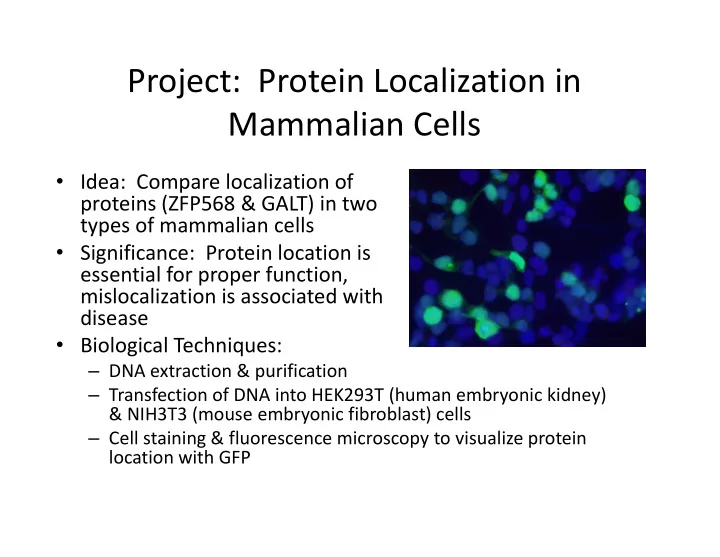

Project: Protein Localization in Mammalian Cells � Idea: Compare localization of proteins (ZFP568 & GALT) in two types of mammalian cells � Significance: Protein location is essential for proper function, essential for proper function, mislocalization is associated with disease � Biological Techniques: � DNA extraction & purification � Transfection of DNA into HEK293T (human embryonic kidney) & NIH3T3 (mouse embryonic fibroblast) cells � Cell staining & fluorescence microscopy to visualize protein location with GFP
Protein Synthesis in the Cell
Diseases associated with defects in protein transport � Cystic fibrosis (CF) � Familial hypercholesterolaemia hypercholesterolaemia (FH) � Congenital sucrase- isomaltase deficiency (CSID)
Project Goal � Compare the localization of two proteins (ZFP568 & GALT) in two types of mammalian cells (human embryonic kidney cells & mouse embryonic fibroblasts) � We’ll do this by � We’ll do this by � Making DNA that codes for our proteins (DNA extraction & purification) � Putting that DNA in mammalian cells (transfection) � Determining where our proteins are within the cells (cell staining & fluorescent microscopy)
Our Project Plan Stain & look at our cells to see where the protein is (Thurs/Fri) Miniprep to extract DNA from bacteria (Tues) Transfect to put our DNA in mammalian cells (Wed)
The Two Cell Types We’ll Use � HEK293T cells (human embryonic kidney) � NIH 3T3 cells (mouse embryonic fibroblast) � Look at the cell morphology of each: How are they different? they different? � Which cell type would you want to use for our project?
The First Protein We’ll Look At � GFP-ZFP568 (Zinc finger protein 568) � Binds to DNA and recruits transcriptional repressor TRIM28 � Mutation (“chato”) causes embryonic arrest Mutation (“chato”) causes embryonic arrest Garcia-Garcia, M.J., Shibata, M., and Anderson, K.V. (2008). Development 135 , 3053-3062.
The Second Protein We’ll Look At � GFP-GALT (Galactose-1-phosphate uridylyltransferase) � Enzyme important in sugar metabolism: Converts galactose to glucose Converts galactose to glucose � Mutation in GALT causes galactosemia � autosomal recessive mode of inheritance
GFP vector – a plasmid DNA coding for ZFP568 or GALT can be inserted here
Restriction Enzymes � XhoI and HindIII � Used to cut (digest) DNA coding for ZFP568 so it could be glued (ligated) into GFP-vector � Digest with these enzymes and DNA coding for ZFP568 should be “cut” from its vector ZFP568 should be “cut” from its vector � Resulting fragments of DNA will be analyzed using gel electrophoresis � What will this gel look like? How will digested GFP-ZFP568 look different from GFP-alone? XhoI HindIII
DNA extraction & purification � GFP-ZFP568, GFP-GALT, and GFP-alone DNA was transformed into bacterial cells � cells were cultured to make more DNA � now DNA can be extracted can be extracted � Qiagen MiniPrep Kit
Transfection � Purified DNA can be transfected into HEK293T and NIH3T3 cells using Lipofectamine 2000 � Mix DNA in media with the Lipofectamine reagent and then add it to your cells’ dish � Cells will take up DNA and express the � Cells will take up DNA and express the proteins (GFP-ZFP568, GFP-GALT, or GFP- alone) within 24hrs � Why do we transfect the GFP-alone construct?
Cell Staining � Phalloidin (red) � Marks actin filaments, concentrated beneath cell membrane to keep cell shape � Actin is part of cytoskeleton � DAPI (blue) � DAPI (blue) � Marks the nuclei of cells � GFP (green) � Tagged to ZFP568 and GALT � Can take pictures of each using fluorescence microscope and then merge using Photoshop � Why do we stain with DAPI and Phalloidin? � Why don’t we have to stain to see ZFP568 or GALT? http://migration.wordpress.com/2007/07/11/basics-the-cytoskeleton/
Final Questions � Where is GFP-GALT and GFP-ZFP568 located within the cell? Why? � What does GFP-alone look like? Why? � Is protein location different in HEK293T or � Is protein location different in HEK293T or NIH3T3 cells? � Why are cells useful for scientists?
Recommend
More recommend